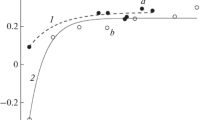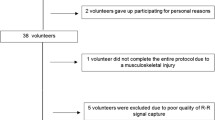Abstract
After collecting data on the cardiovascular responses to ramp-type exercise tests on a cycle ergometer from 194 healthy male and female subjects aged from 20 to 69 years, we constructed a mathematical model that simulates typical patterns of the cardiovascular variability responses to ramp-type exercise loads below the anaerobic threshold. This was done by reflecting the following physiological mechanisms: (1) suppression of parasympathetic nerve activity, (2) reduction of total peripheral resistance, (3) resetting of the operating point in the baroreflex curve, (4) increase in stroke volume, and (5) increase in the coupling of stroke volume to pulse pressure. We estimated the values of model parameter that best fit the measured experimental data. The estimated steepness of the slope with which parasympathetic nerve activity decreased was lower in subjects with a higher anaerobic threshold, tended to increase with age, and in every age decade was higher for females than for males.





Similar content being viewed by others
References
Baselli G, Cerutti S, Badilini F, Biancardi L, Porta A, Pagani M, Lombardi F, Rimoldi O, Furlan R, Malliani A (1994) Model for the assessment of heart period and arterial pressure variability interactions and of respiration influences. Med Biol Eng Comput 32:143–152
Beaver WL, Wasserman K, Whipp BJ (1986) A new method for detecting anaerobic threshold by gas exchange. J Appl Physiol 60:2020–2027
Cameron JD, Bulpitt CJ (2003) Aging for the cardiovascular system. In: Aspinall R (ed) Aging of organs and systems. Kluwer, Netherlands, pp 137–152
Deboer RW, Karemaker JM, Strackee J (1987) Hemodynamic fluctuations and baroreflex sensitivity in humans: a beat-to-beat model. Am J Physiol-Heart C 253:H680–689
Decety J, Jeannerod M, Durozard D, Baverel G (1993) Central activation of autonomic effectors during mental stimulation of motor actions in man. J Physiol 461:549–563
Ellestad MH (2003) Stress testing: principles and practice. Oxford, New York
Ferrari AU, Radaelli A, Centola M (2003) Invited review: aging and the cardiovascular system. J Appl Physiol 95:2591–2597
Frolkis VV, Bezrukov VV, Kulchitsky OK (1996) The aging cardiovascular system. Springer, New York
Kotani K, Struzik ZR, Takamasu K, Stanley HE, Yamamoto Y (2005) Model for complex heart rate dynamics in health and diseases. Phys Rev E 72:041904
Levenberg KA (1944) Method for the solution of certain problems in least-squares. Q Appl Math 2:164–168
Li X, Bai J (2001) Computer simulation of the baroregulation in response to moderate dynamic exercise. Med Biol Eng Comput 39:480–487
Magosso E, Ursino M (2002) Cardiovascular response to dynamic aerobic exercise: a mathematical model. Med Biol Eng Comput 40:660–674
Marquardt D (1963) An algorithm for least-squares estimation of nonlinear parameters. SIAM J Appl Math 11:431–441
Neder JA, Nery LE, Peres C, Whipp BJ (2001) Reference values for dynamic responses to incremental cycle ergometry in males and females aged 20 to 80. Am J Resp Crit Care 164:1481–1486
Ohsuga M, Shimono F, Genno H (2001) Assessment of phasic work stress using autonomic indices. Int J Psychophysiol 40:211–220
Pollock ML, Gaesser GA, Butcher JD (1998) The recommended quantity and quality of exercise for developing and maintaining cardiorespiratory and muscular fitness, and flexibility in healthy adults. Med Sci Sport Exer 30:975–991
Porta A, Baselli G, Rimoldi O, Malliani A, Pagani M (2000) Assessing baroreflex gain from spontaneous variability in conscious dogs: role of causality and respiration. Am J Physiol-Heart C 279:H2558–H2567
Porta A, Baselli G, Cerutti S (2006) Implicit and explicit model-based signal processing for the analysis of short-term cardiovascular interactions. Proc IEEE 94:805–818
Raven PB, Fadel PJ, Ogoh S (2006) Arterial baroreflex resetting during exercise: a current perspective. Exp Physiol 91:37–49
Rosenblueth A, Simeone FA (1934) The interrelations of vagal and accelerator effects on the cardiac rate. Am J Physiol 110:42–55
Rowell LB (1993) Human cardiovascular control. Oxford University Press, New York
Seals DR, Taylor JA, NG AV, Esler MD (1994) Exercise and aging: autonomic control of the circulation. Med Sci Sport Exer 26:568–576
Seidel H, Herzel H (1998) Bifurcations in a nonlinear model of the baroreceptor-cardiac reflex. Physica D 115:145–160
Turner MJ, Mier CM, Spina RJ, Schechtman KB, Ehsani AA (1999) Effects of age and gender on the cardiovascular responses to isoproterenol. J Gerontol A Biol 54:B393–400
Gulli G, Cevese A, Cappelletto P, Casparini G, Schena F (2003) Moderate aerobic training improves autonomic cardiovascular control in older women. Clin Auton Res 13:196–202
Ursino M (1999) A mathematical model of the carotid baroregulation in pulsating conditions. IEEE T Bio-Med Eng 46:382–392
Yoshino K, Motoshige T, Araki T, Matsuoka K (2004) Beat-to-beat model of the cardiovascular system in response to mental task stress (in Japanese). Trans Jpn Soc Med Biol Eng 42:290–299. Retrieved from URL: http://sciencelinks.jp/j-east/display.php?id=000020051305A0316097
Yoshino K, Matsuoka K (2005) Causal coherence analysis of heart rate variability and systolic blood pressure variability under mental arithmetic task load. Biol Psychol 69:217–227
Yoshino K, Hayakawa M, Niki E, Matsuoka K (2005) Closed-loop analysis of cardiovascular variability in rats under restraint stress. Auton Neurosci-Basic 119:61–66
Author information
Authors and Affiliations
Corresponding author
Electronic supplementary material
Below is the link to the electronic supplementary material.
Rights and permissions
About this article
Cite this article
Yoshino, K., Adachi, K., Ihochi, K. et al. Modeling effects of age and sex on cardiovascular variability responses to aerobic ergometer exercise. Med Bio Eng Comput 45, 1085–1093 (2007). https://doi.org/10.1007/s11517-007-0282-y
Received:
Accepted:
Published:
Issue Date:
DOI: https://doi.org/10.1007/s11517-007-0282-y




